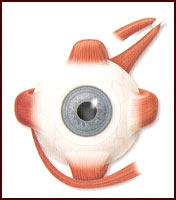FAQ’s -
Adult Strabismus
What is adult strabismus?
Strabismus (pronounced "struh-BIZ-mus") is a condition in which the eyeballs are not aligned properly and pOint in different directions. When it occurs in adults, it is called adult strabismus. Nearly four in every 100 adults have adult strabismus.
What causes strabismus in adults?
Most adults with strabismus have had the condition since childhood. However, strabismus can also begin in adulthood due to medical problems such as :
• diabetes;
• thyroid disease (Graves disease);
• myasthenia gravis;
• brain tumors;
• head trauma;
• strokes.
Occasionally, misalignment of the eyes can also occur after surgery on or around the eye, such as cataract surgery or retinal surgery, due to damage to the eye muscles during surgery.
What are the symptoms of adult strabismus?
Adults with strabismus may experience :
• eye fatigue;
• double vision (diplopia);
• overlapped or blurred images (visual confusion);
• a pulling sensation around the eyes;
• reading difficulty;
• loss of depth perception.
To correct their inability to focus properly, many adults with strabismus have to tilt or turn their heads when focusing. They also are unable to make direct eye contact with both eyes when looking at people, which can make social situations awkward.
These symptoms may have a negative impact on employment and social opportunities.
How is adult strabismus treated?
Adult strabismus can be treated using several methods including :
• eye muscle exercises;
• eyeglasses containing prisms;
• botulinum toxin (Botox®) injections;
• eye muscle surgery.
• reading difficulty;
Eye muscle exercises. Muscle exercises can be helpful in treating a form of adult strabismus in which the eyes cannot align themselves for close work or reading. This condition is called convergence insufficiency.
Close work requires you to focus both eyes inward on close objects (papers, books, needle and thread, computer screens, etc.). The coordinated movement and inward focusing of the eyes is called convergence. Your ophthalmologist (Eye M.D.) can provide home eye muscle exercises to help them re–train the eyes to focus inward together. However, eye muscle exercises are rarely useful in other cases of adult strabismus.
Prism eyeglasses. Eyeglasses with prisms can correct mild double vision associated with adult strabismus. A prism is a clear, wedge–shaped lens that bends, or refracts, light rays. When worn by an adult with strabismus who has mild double vision, the prism eyeglasses realign images together so that the eyes see only one image. The prisms can be worn on the outside of the eyeglass frames or can be manufactured directly into the lens itself.
Prism eyeglasses usually cannot correct more severe cases of double vision where images are far apart or double vision caused by paralytic (weak) or restricted (tight) muscles.
Botox injections. If an overreactive eye muscle is the cause of the strabismus, Botox injections can often stabilize the muscle and relieve the symptoms of strabismus. Botox is a drug that, when injected in small amounts, temporarily paralyzes muscles. When injected into the eye muscle, the effects can last several months and may even cause a permanent change in eye alignment.
Eye muscle surgery. Eye muscle surgery is the most common treatment for strabismus. Typically, strabismus occurs when the muscles surrounding the eyes are either too stiff or too weak. An ophthalmologist can surgically loosen, tighten, or repOSition selected eye muscles so that the eyes can be rebalanced to work together.
Surgery can :
• improve eye alignment;
• reduce or eliminate double vision;
• improve or restore the use of both eyes together (binocular visual function);
• reduce eye fatigue;
• expand peripheral (side) vision;
• improve social and professional opportunities.

Eye muscles
Strabismus surgery is usually performed on an outpatient basis using general or local anesthesia. You may experience some pain or discomfort after surgery, but it is usually not severe and can be treated with over–the–counter pain medication such as acetaminophen (Tylenol®) or ibuprofen (Motrin®). Stronger medications for pain, such as codeine or hydrocodone, are sometimes needed and will be prescribed by your ophthalmologist.
You can often return to your normal activities within a few days.
More than one surgery may be needed to treat strabismus.
Adjustable sutures surgery
To obtain more precise alignment of your eyes, your ophthalmologist may use adjustable sutures (stitches). This allows your eye alignment to be adjusted after surgery. If adjustable sutures are used, surgery is performed in two stages. Stage one involves repositioning one or more of the eye muscles with "slipknot" or "bow–tie" sutures. In stage two (usually performed within the following 24 hours), using anesthetic eyedrops, the sutures are untied and retied to fine–tune the alignment. In many cases, no adjustment is needed and the slipknot or bow–tie sutures are converted to standard knots.
Adjustable sutures can be used only in certain types of eye muscle surgeries and may not be suitable for everyone.
What are the risks of strabismus surgery?
Vision loss from strabismus surgery is extremely rare. However, as with all surgeries, there are also risks associated with strabismus surgery. Complications can include :
• allergic reaction to the anesthesia;
• infection;
• reduced vision;
• double vision;
• inadequate eye alignment.
It is never too late to treat strabismus?
Adults do not need to live with the discomfort and problems caused by misaligned eyes. With your ophthalmologist's help, surgery and/or a combination of other treatment methods can improve the symptoms associated with strabismus.
Copyright 2017 Manishankar Eye Hospital. All Rights Reserved.



